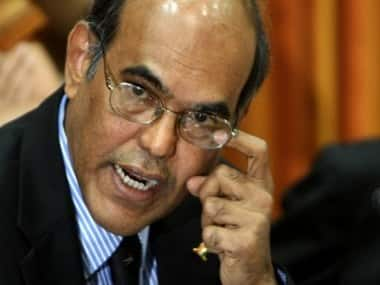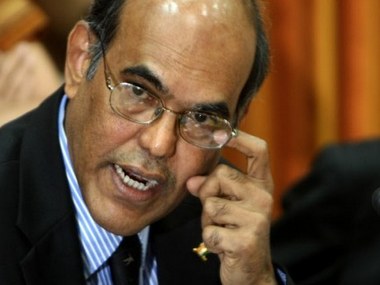Few will envy Reserve Bank of India (RBI) governor Duvvuri Subbarao’s job at this point.
The RBI boss, who will unveil a review of Monetary Policy on 24 January, has a tough tightrope walk to execute this time, caught between the rising clamour for a rate cut, and an inflation level which the RBI still may not be totally comfortable with.
The jury is well and truly out this time on whether RBI will bit the bullet and start a reversal of the rate cycle.
[caption id=“attachment_191076” align=“alignleft” width=“380” caption=“Reserve Bank of India governor Duvvuri Subbarao will unveil a review of Monetary Policy on 24 January. Pal Pillai/AFP”]
 [/caption]
[/caption]
In an interview with The Financial Express , the newly elected Ficci president RV Kanoria has already upped the ante and called for a cut of at least 50 basis points in rates, now that inflation has come down. Kanoria tells the paper that the present rates are contributing to manufactured goods inflation, and affecting the masses.
That Subbarao is under enormous pressure this time is also borne out by a Business Standard story which, quoting unnamed finance ministry sources, says that the ministry would want RBI to lower rates now, since high rates have begun hurting growth and investment. In fact, the story even mentions that, in the ministry’s view, Subbarao should have paused earlier than December 2011.
The signals are mixed, to say the least. But if the last Index of Industrial Production (IIP) numbers are anything to go by, there is still not enough indication that the growth momentum is back, as has been argued earlier in Firstpost.
There is still the ’empty middle’ to contend with: while the upstream basic goods and consumer goods sectors are performing well, capital goods and intermediate goods remain sluggish.
So clearly, the growth has been uneven, patchy and sputtering.
Subbarao met finance minister Pranab Mukherjee on Friday, and reviewed the macroeconomic situation, and that will obviously weigh heavily on the RBI’s mind, even as corporate result trends, too, show a clear slowdown.
Moody’s has stuck its neck out and voted for a rate cut sometime in February, while HSBC’s economic forecast takes the other view - that it is ‘still too early to cut’, since growth conditions have improved slightly and core inflation remains elevated, negating a compelling reason for a rate cut.
Standard Chartered, on the other hand, seems to be betting on a cut in cash reserve ratio (CRR), and also sees growth moderation weighing on policymakers’ minds. Whether that will translate into RBI action is the key question. Fitch, meanwhile, has sliced its growth projection for India to 7 percent from the earlier 7.5 percent.
Subbarao’s predecessor Yaga Venugopal Reddy had an interesting view on the point of RBI listening to the finance ministry’s advice.
Reddy would say, in his inimitable double-negative sort of way, that an argument need not be negated just because it came from the ministry.
However, Reddy also believed action need not always be taken on a particular day just because there is a policy review, and could always be kept for an exact and appropriate time, and any reaction from the central bank must be purely ‘contextual’.
It will be interesting to watch which of Reddy’s arguments Subbarao opts for this time.
Sourav Majumdar has been a financial journalist for over 18 years. He has worked with leading business newspapers and covered the corporate sector and financial markets. He is based in Mumbai.
)